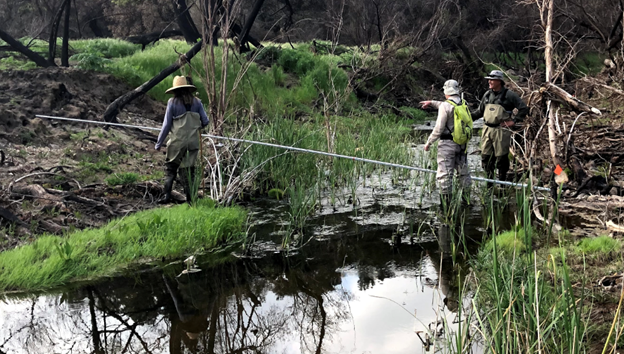The third cycle of the SMC’s Regional Watershed Monitoring Program kicked off this year with an updated monitoring design that builds on previous stream surveys, while simultaneously expanding the collaborative, regional program into new frontiers.
Program participants plan to conduct field sampling at 475 stream sites spanning 15 major watershed areas across coastal southern California over a five-year period, 2021 to 2025.
Environmental managers depend on the program to provide key insights about regional stream health over time. Last year, the SMC published an analysis of the first decade of regional stream monitoring data that found that the biological health of the majority of stream-reaches neither improved nor declined from 2008 to 2018.
Similarly, an analysis of the first cycle of SMC stream monitoring found that the top three stressors mostly likely responsible for biological degradation of the region’s streams were nutrients, major ions and degraded habitat.
The SMC uses the program’s comparable, statistically representative data sets each year to assess the ecological health of 7,000 stream-kilometers that drain to southern California’s coastal ocean.

The design of the SMC’s third regional monitoring cycle – described in a published workplan – will focus on trend assessments, enabling the SMC to continue tracking stream condition over time. The program’s 2021-2025 cycle also will encompass special studies to address three key areas of management interest:
- Generating higher-resolution insights for priority areas: The SMC will target particular areas that tend to be under-sampled via the core monitoring program, including restored sites, soft-bottom channels, small urban streams and other sites that help SMC member agencies answer priority management questions.
- Cost-efficient stream causal assessments: The SMC will use a novel, rapid screening approach to causal assessment to determine specifically why some stream sites with degraded water quality score low using bioassessment-based stream scoring tools. SMC monitoring will adapt over the five years of the survey to investigate likely causes of degradation – but in a cost-efficient way that won’t increase monitoring costs.
- Mapping wet and dry streams: The SMC will map wet and dry streams in the region to better understand which streams are ephemeral, intermittent, or perennial – key insights that can help managers better understand the extent of aquatic resources, as well as identify which streams could be subject to State and regional biological objectives.
The expanded workplan overall is a cost-neutral survey for program participants, as the extensive stream data that was collected during previous program cycles has reduced the need to collect as much core monitoring data going forward.
Dive deeper
- Learn more about the three special studies planned for SMC 2021-2025 regional stream monitoring
- See the full list of contributors to the third cycle of the SMC’s regional monitoring program
- Read the full workplan outlining the monitoring design of the SMC’s 2021-2025 Regional Watershed Monitoring Program (PDF report)
- Explore the SMC Regional Watershed Monitoring Program’s publicly accessible data portal for bioassessment and other stream condition data
SMC Summer 2021 Newsletter
Volume 2, Issue 1
This newsletter is published three times a year by the Southern California Stormwater Monitoring Coalition (SMC). To subscribe to this newsletter, contact [email protected].
